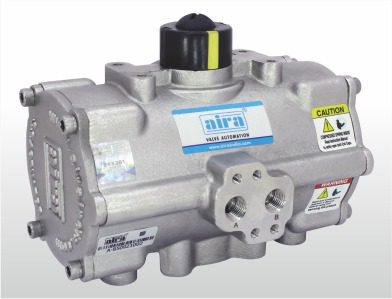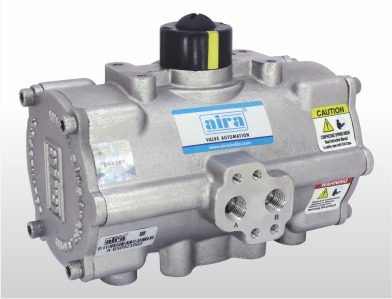A crucial factor in selecting the right pneumatic valve actuator is considering its operating pressure range. The actuator’s capability to perform effectively under specific pressure conditions ensures reliable valve control and system efficiency. Here are some key points to consider:
- Optimal Performance: Understanding the operating pressure range helps ensure that the pneumatic valve actuator operates within its design specifications, delivering peak performance in varying pressure conditions.
- Safety and Reliability: Choosing an actuator that matches the system’s pressure requirements prevents potential overloading or underperformance, enhancing the overall safety and reliability of the system.
- Environment Adaptability: Different applications may involve varying pressure environments. Selecting an actuator with a suitable pressure range allows it to adapt to specific working conditions seamlessly.
- System Longevity: Operating pneumatic valve actuators within their recommended pressure range minimizes wear and tear, prolonging their service life and reducing maintenance costs.
- Avoiding Costly Errors: Overlooking pressure range considerations can lead to actuator failure, downtime, and potential system damage, all of which can be costly to rectify.
Ensuring the pneumatic valve actuator’s operating pressure range aligns with the application’s requirements guarantees efficient and trouble-free valve control, optimizing the overall performance of the system.
Valve Size and Torque Requirements: Matching Actuator Performance
When selecting a pneumatic valve actuator, one of the critical considerations is ensuring that the actuator’s size and torque capabilities align with the specific valve it will be controlling. The valve size and the amount of torque needed to actuate it are crucial factors that directly impact the overall performance and efficiency of the pneumatic valve actuator system.
- Proper Torque Calculation: Begin by accurately calculating the torque necessary to operate the valve. Consider factors such as the valve’s size, pressure, flow rate, and the level of resistance it encounters during operation.
- Actuator Torque Rating: Once the torque requirements are established, choose a pneumatic valve actuator with a torque rating that meets or slightly exceeds the calculated torque value. Having an actuator with sufficient torque ensures smooth and reliable valve operation.
- Avoid Under-Actuation or Over-Actuation: Selecting an actuator with insufficient torque may result in under-actuation, leading to incomplete valve closure or failure to open fully. Conversely, an actuator with excessive torque can cause over-actuation, potentially damaging the valve or the actuator itself.
- Consider Safety Factors: It’s prudent to include safety factors when determining the required torque. Safety margins provide a buffer for unexpected changes in operating conditions and prevent the actuator from operating at its limits.
- Future Growth and Expansion: Anticipate any future changes in the system, such as expansion or modifications, and ensure the selected pneumatic valve actuator has enough torque capacity to accommodate these changes.
Selecting a pneumatic valve actuator that matches the valve size and torque requirements is vital for optimal system performance, efficiency, and longevity. Properly matching the actuator’s capabilities ensures reliable valve control and enhances the overall operation of the pneumatic valve actuator system.
Environmental Factors: Assessing the Impact on Actuator Selection
When selecting the right pneumatic valve actuator for a specific application, it is crucial to consider the environmental factors that may influence its performance and longevity. Various conditions can significantly impact the actuator’s effectiveness, durability, and overall reliability. Here are some key environmental factors to assess during the actuator selection process:
- Temperature Range: Pneumatic valve actuators operate within a specific temperature range. Extreme temperatures, whether hot or cold, can affect the actuator’s materials, seals, and lubrication, potentially leading to malfunctions or reduced efficiency. It is essential to choose an actuator that can withstand the operating temperature of the intended environment.
- Humidity and Moisture Levels: Excessive humidity or moisture can cause corrosion and damage to the actuator’s components, especially if they are not adequately protected. Opting for actuators with proper sealing and coating can mitigate the risks associated with high humidity environments.
- Hazardous or Corrosive Atmospheres: Some industrial applications involve hazardous or corrosive substances that could adversely affect the actuator’s materials. Selecting pneumatic valve actuators constructed from corrosion-resistant materials or employing protective coatings becomes imperative in such environments.
Considering the impact of environmental factors on pneumatic valve actuators ensures optimal performance and prolongs the actuator’s service life in challenging operational conditions. By addressing these factors in the selection process, engineers can make informed decisions and choose actuators that are best suited for the specific application’s environmental demands.

Actuator Type: Choosing Between Rotary and Linear Actuators
When it comes to selecting the right pneumatic valve actuator for a specific application, one of the crucial considerations is the actuator type. Pneumatic valve actuators can be broadly categorized into two main types: rotary actuators and linear actuators. Each type offers distinct advantages and is suited for different scenarios based on the requirements of the system. Understanding the differences between these actuator types can help engineers and system designers make informed decisions to achieve optimal performance and efficiency.
Rotary Actuators:
- Rotary actuators convert pneumatic energy into rotational motion, making them suitable for applications that require valve rotation, such as ball valves and butterfly valves.
- They offer a compact and simple design, which can be advantageous in space-constrained installations.
- Rotary actuators provide a higher torque output compared to linear actuators, making them ideal for valves that require higher operating forces.
Linear Actuators:
- Linear actuators, as the name suggests, convert pneumatic energy into linear motion, making them suitable for applications that require linear valve movement, such as globe valves and gate valves.
- They offer precise control over the valve position, making them suitable for applications that demand accuracy and repeatability.
- Linear actuators are often preferred in cases where a linear force output is necessary to actuate large or heavy valves.
Choosing between rotary and linear actuators for a pneumatic valve actuator depends on the specific valve type, control requirements, available space, and the desired level of precision. By carefully evaluating these factors, engineers can make an informed decision to ensure the selected actuator type meets the operational needs of the system while maximizing its performance and longevity.
Control System Compatibility: Integration with Existing Infrastructure
Ensuring seamless integration of a pneumatic valve actuator with the existing control system is crucial for optimal performance and efficient operation. The compatibility of the actuator with the control infrastructure determines the overall reliability and functionality of the system. Here are some key points to consider when evaluating control system compatibility for a pneumatic valve actuator:
- Protocol and Communication: Check if the actuator supports the communication protocol used in the current control system, such as Modbus, Profibus, or Foundation Fieldbus.
- Signal Input: Ensure that the actuator’s signal input requirements match the output signals of the existing control system to avoid compatibility issues.
- Signal Conversion: If there are discrepancies between the control system’s output and the actuator’s input signals, consider using signal converters or adapters to bridge the gap.
- Feedback Mechanism: Verify whether the actuator provides feedback data compatible with the control system to enable accurate monitoring and closed-loop control.
- Software Integration: Assess if the actuator’s configuration and diagnostic software are compatible with the control system’s interface for seamless data exchange and parameter adjustments.
By carefully evaluating and addressing control system compatibility, the integration of the pneumatic valve actuator becomes smoother, optimizing its performance within the existing infrastructure and ensuring a reliable and efficient system overall.
Speed and Response Time: Optimizing Actuator Performance
When it comes to pneumatic valve actuators, achieving optimal speed and response time is crucial for efficient and precise control of fluid flow. The actuator’s ability to promptly respond to control signals directly impacts the overall system’s performance. Here are key considerations for optimizing speed and response time:
- Air Supply and Pressure: Ensure an adequate and consistent air supply to the pneumatic valve actuator. Proper pressure levels enable quick actuation and minimize response delays.
- Actuator Size and Design: Selecting the right actuator size and design for your specific application can significantly affect response time. Appropriately sized actuators with low friction components tend to respond faster.
- Valve Weight and Friction: Consider the weight and friction of the valve being actuated. Lighter valves with lower friction coefficients allow for quicker responses.
- Control System Tuning: Fine-tune the control system parameters to optimize actuator response. This includes adjusting signal timings and gain settings.
- Positioning Sensors: Implement accurate positioning sensors to provide real-time feedback. These sensors enable the control system to adjust the actuator promptly, improving response time.
By carefully addressing these factors, the speed and response time of your pneumatic valve actuator can be optimized, resulting in improved system performance and enhanced overall productivity.
Safety Considerations: Ensuring Reliable Valve Actuation
When dealing with pneumatic valve actuators, prioritizing safety is of paramount importance to avoid potential hazards and ensure smooth and secure operations. Here are crucial safety considerations to keep in mind:
- Valve Actuator Selection: Opt for pneumatic valve actuators that are specifically designed and rated for the intended application, taking into account the operating environment and pressure requirements. Properly matched actuators reduce the risk of failures and enhance overall safety.
- Position Monitoring: Implement effective position monitoring systems to provide real-time feedback on the valve’s status. This allows operators to identify any anomalies promptly and take appropriate action.
- Emergency Shutdown Procedures: Establish well-defined emergency shutdown procedures that operators can execute in case of unexpected events. This ensures a swift response to potential emergencies and minimizes the risk of accidents.
- Overpressure Protection: Incorporate pressure relief devices or safety valves to prevent the pneumatic valve actuator from operating beyond safe pressure limits. Overpressure protection safeguards against equipment damage and potential injuries.
- Regular Maintenance and Inspection: Conduct routine maintenance and inspection of pneumatic valve actuators to detect wear, tear, or any potential defects early on. Scheduled maintenance enhances reliability and reduces the likelihood of unexpected malfunctions.
By diligently adhering to these safety considerations, the risk of accidents and unplanned downtime can be significantly mitigated, ensuring the reliable performance of pneumatic valve actuators in industrial applications.
Maintenance and Lifecycle Costs: Evaluating Long-Term Viability
Proper maintenance and a thorough evaluation of lifecycle costs are critical aspects to consider when selecting a pneumatic valve actuator for any industrial application. The decision made in this regard can significantly impact the overall efficiency and cost-effectiveness of the system in the long run. Here are some key points to take into account during the evaluation process:
- Regular Maintenance: Pneumatic valve actuators require routine maintenance to ensure optimal performance and longevity. This includes inspecting for wear and tear, lubrication, and cleaning of components.
- Spare Parts Availability: Assessing the availability and cost of spare parts is crucial as it directly affects downtime in case of repairs.
- Actuator Lifespan: Understanding the expected lifespan of the pneumatic valve actuator aids in predicting replacement schedules and budgeting for future investments.
- Energy Efficiency: Evaluating the actuator’s energy consumption and efficiency helps in estimating operational costs over the long term.
- Reliability and Durability: Choosing a well-built and reliable actuator can prevent frequent breakdowns and reduce the need for costly replacements.
Considering maintenance and lifecycle costs alongside other factors ensures the optimal selection of a pneumatic valve actuator that aligns with your industrial requirements and budget constraints.


